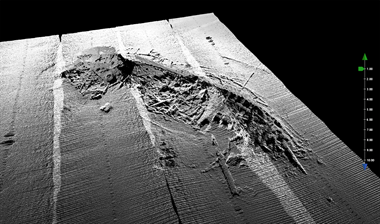DLR investigates munitions disposal areas and archaeological sites in the Kiel Fjord

For the second time, DLR Bremerhaven is accompanying researchers from Kiel University and the German Maritime Museum on a measuring expedition in the Baltic Sea. The "Technology Testing Systems" research group has been welcomed as guests on the research cutter Littorina, which has its home port in Kiel.
In addition to hydrographical mapping of archaeological sites, the team tested the 3D-recording of structures under water. The numerous wreck sites as well as tons of dumped ammunition in the Kiel Fjord offer many possibilities for the use of the autonomous underwater vehicle "SeaCat".

A very special highlight of the mission was the survey of the three-masted barque "Voitja". The approx. 36-metre-long former three-master served as a guard ship after its conversion. The Voitja sank in the spring of 1945, supposedly as a result of an aircraft mine hit in the Kiel Fjord. The location in the busy shipping lane makes a classic mapping of the wreck site by divers difficult. The use of an autonomous underwater vehicle enables a submerged survey of the site without having to surface in the shipping lane. The use of state of the art multibeam and sidescan sonars enables high-resolution images of the wreck site. The 3D reconstruction and the resulting model provide impressive insights into the condition of the ship and allow the archaeologists to analyse the site and draw conclusions about the course of the accident.
Not far from the "Voitja", the research group mapped the remains of an English bombing aircraft from the Second World War. The crashed debris are spread over a wide area, essential parts such as wings, parts of the fuselage and engines are clearly visible on the acoustic images. A relation between the sinking of the "Voitja" and the crash of the English bomber not documented.
Several seabed sinks in the coastal area near Strande were investigated with the Subbottom profiler. This low-frequency sonar is able to penetrate the seabed up to several meters, depending on its composition characteristics, and thus locate objects under the sediment. Remains of former settlements are suspected in the seabed sinks near the cliffs. Findings in this area date mainly to the Middle Stone Age between 5200-5000 BC.
"The experience of the underwater archaeologists in identifying objects and structures on the seafloor helps us to plan missions and tasks with the underwater sensors much more accurately and effectively", Dr David Heuskin, head of the Technology Testing Systems Group." In turn, the SeaCat is proving to be a powerful tool in surveying archaeological sites and wreck sites. We are very excited about the collaboration and the opportunity to test our vehicle on different challenges."



